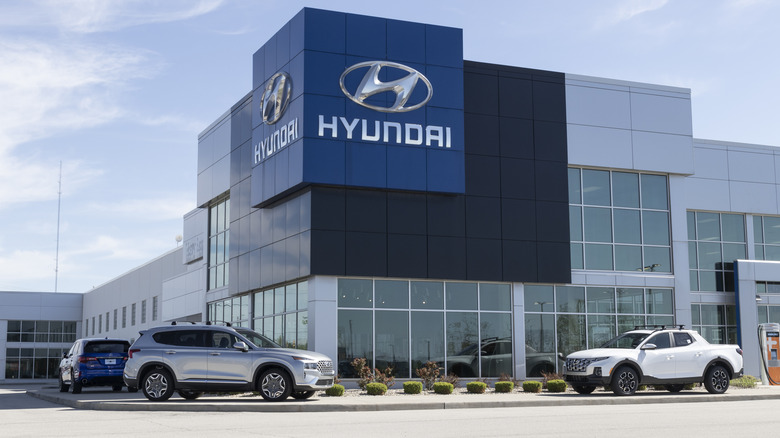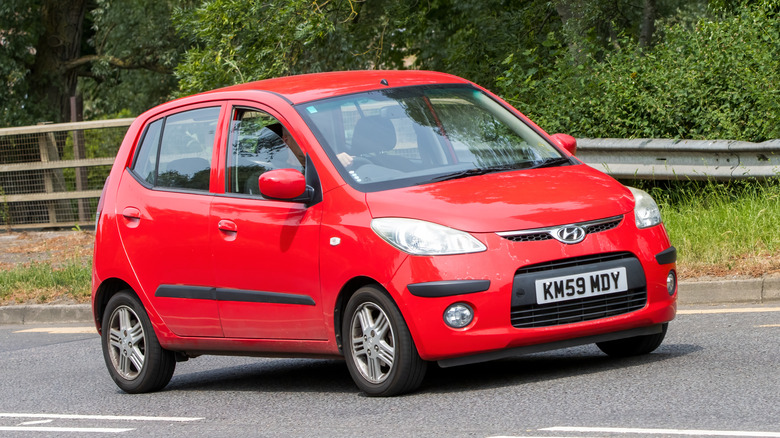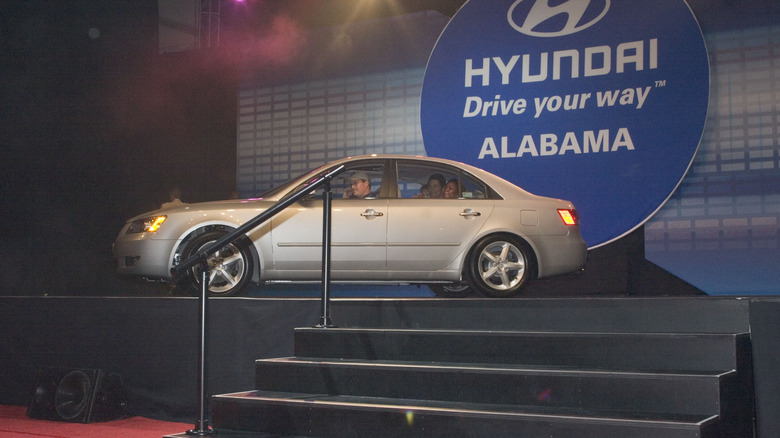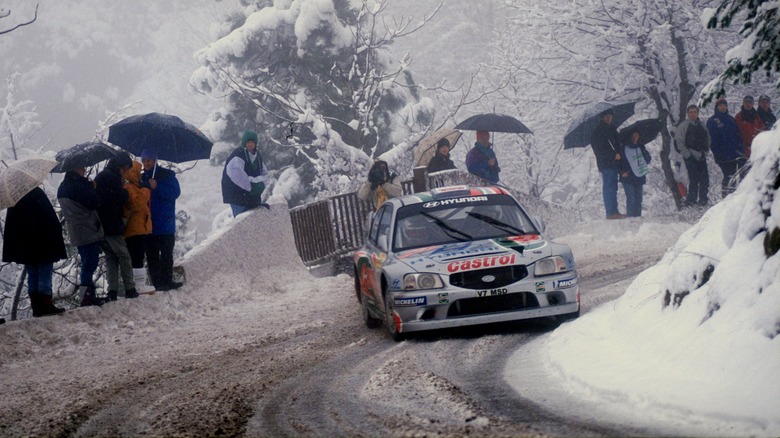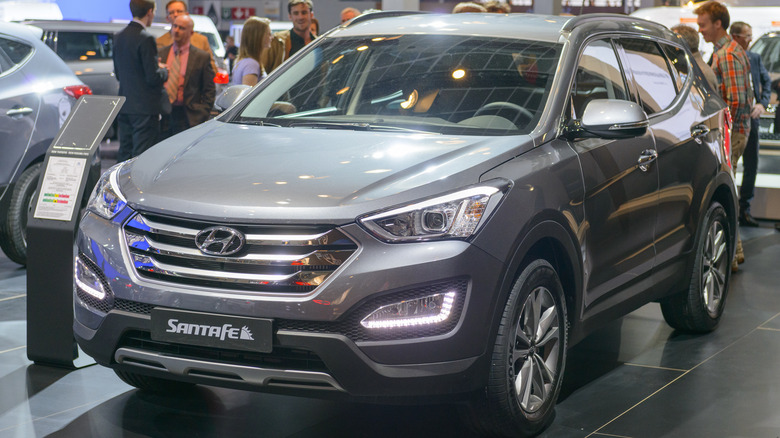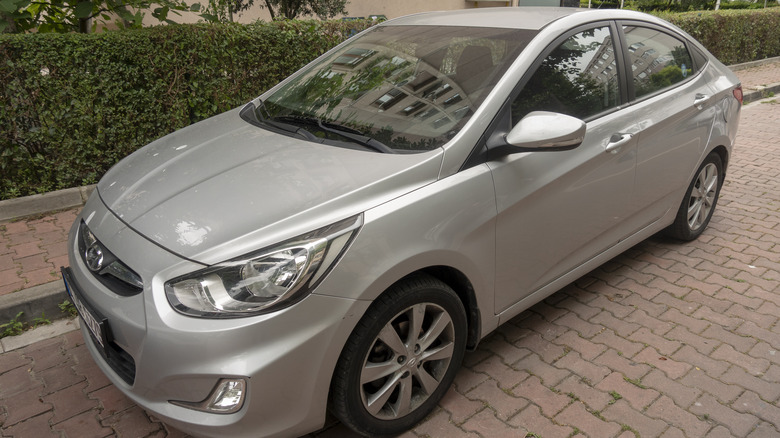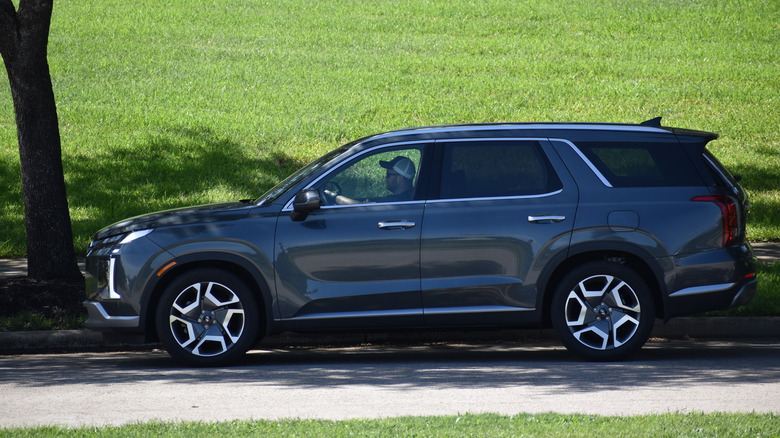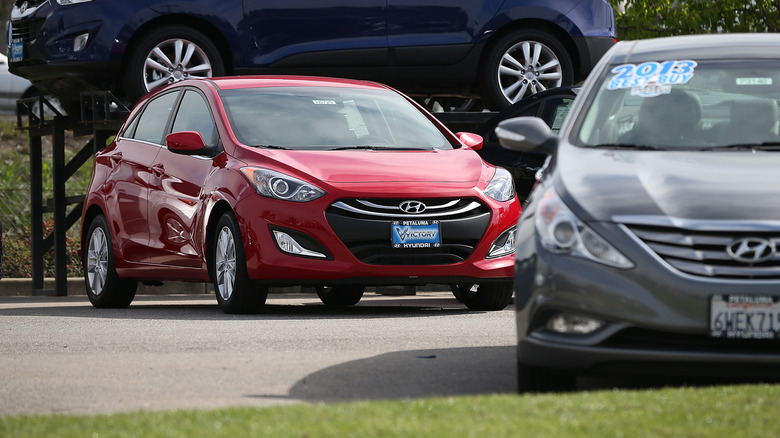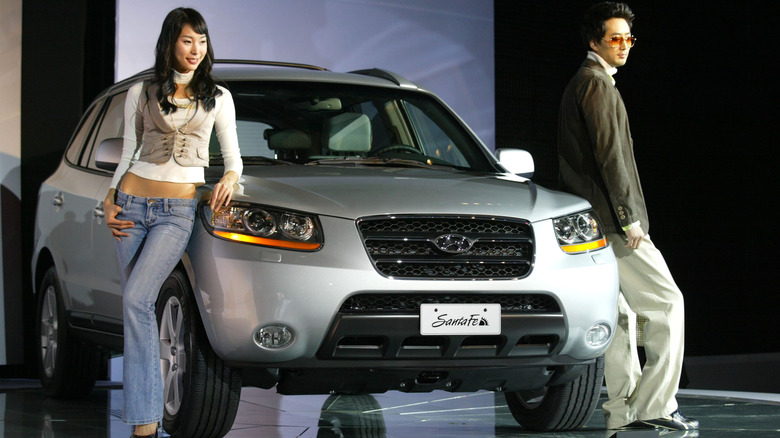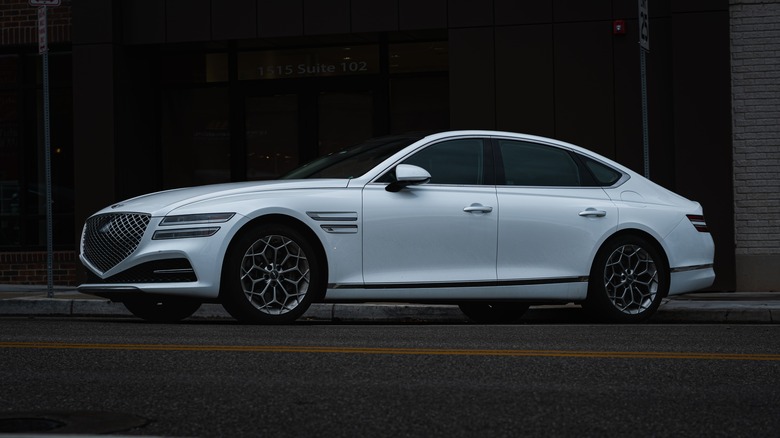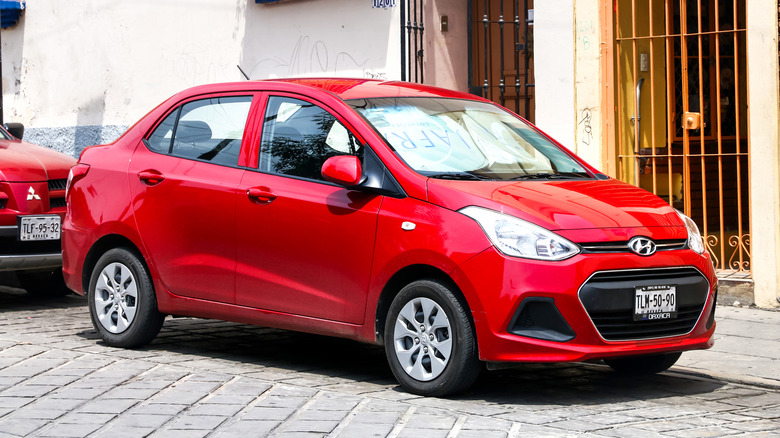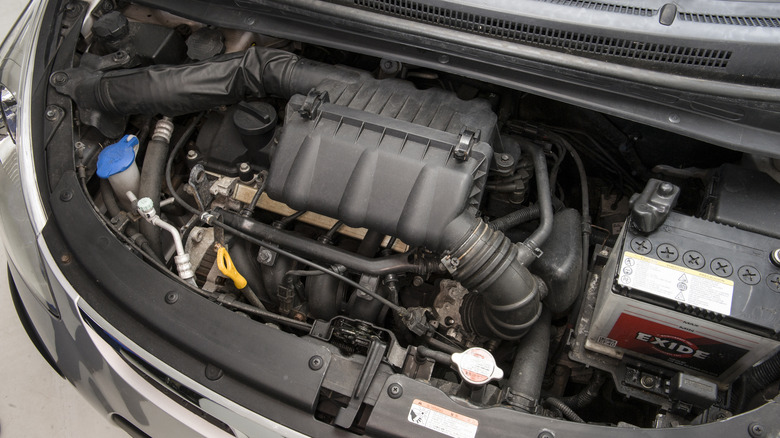10 Of The Most Reliable Hyundai Engines Ever Built
Hyundai has always been an interesting company. The South Korean car giant was originally founded in the 1940s as an engineering and construction company. It was awarded many government contracts in the wake of the South Korean liberation, which resulted in Hyundai assisting in building the entire country's transportation infrastructure. In the 1960s, Hyundai Motor Company was founded. For years, the company worked hand-in-hand with Ford to build vehicles like the Ford Cortina. The 1970s saw Hyundai make its first car, the Pony; the first mass-produced car in Korea.
The early years for Hyundai were mostly designing and building cars comprised of parts from other companies. For example, Hyundai used engines manufactured by Mitsubishi for much of the first two decades of its existence. As you browse through the list, you'll no doubt notice a lack of engines before 1990. That's because Hyundai didn't make engines back then. However, we have it on good authority that Mitsubishi built some reliable engines back in the day.
Hyundai has since cleaned up its act as the company makes fairly reliable cars. RepairPal, a website that crowdsources repairs, gives Hyundai a steady four out of five rating and ranks it in the top five most reliable car brands today. That isn't to say that Hyundai hasn't had issues. The Theta II disaster, for instance, was a thorn in Hyundai's side for years. Still, by and large, Hyundai makes some pretty solid products.
Here are the most reliable engines that Hyundai has ever made.
10. Hyundai Gamma 1.4L (G4FC)
The Hyundai Gamma 1.4-liter Inline-4 is an engine that Hyundai still uses on its least expensive vehicles. The number of vehicles that carries it is relatively low compared to some of the other engines on this list. You'll find it in the Hyundai Accent, Kia Rio, Kia Ceed, Hyundai i20, and Hyundai i30. These engines are small and relatively slow. They're meant for vehicles that putt around town rather than cruising at highway speeds. Even so, it's not a bad engine for what it is.
At its core, the Gamma 1.4L inline-4 looks good on paper. The engine is made of an aluminum block with aluminum cylinder heads. It also comes equipped with a timing chain instead of a timing belt, as well as a CVVT system on the intake camshaft. Most variants of the engine come in at right around 100 horsepower and 100 pound-feet of torque. So, you won't be tearing up the streets in a car equipped with this engine. Its mostly meant for grocery-getters.
The most common complaints include knocking noises, engine vibrations, and carbon buildup. Somewhat humorously, those aren't broken components. They're just how the engine works. Cars equipped with the 1.4-liter score are fairly average on JD Power, although the company doesn't have ratings on every vehicle equipped with this engine. RepairPal shows the occasional engine issue, but nothing too problematic. It won't last 200,000 miles, but it should handle 100,000 or more pretty easily.
9. Hyundai 2.4L NF (G4KC)
It is well-known that the Theta II engines were pretty bad. However, the Theta I engines were pretty decent. Hyundai used this engine in the mid-2000s and is often lumped together with its more disastrous Theta II sibling. The engine appeared in the Hyundai Sonata and Grandeur alongside the Kia Optima and Rondo. It wasn't Hyundai's most widely used engine, so there isn't much data about it. However, it was wildly more reliable than the Theta II that would come later.
The G4KC variant of the engine produced 162 horsepower and 164 pound-feet of torque. It features an aluminum open-deck cylinder block and aluminum cylinder heads. It was also equipped with multi-point fuel injection (MPI), which helped stave off carbon build-up. It is mechanically similar to the 2.0-liter Theta engine as well, which was another headache for Hyundai in terms of reliability. It's a small wonder that this particular variant of the engine survived unscathed while the rest of the Theta I and II engines were total trainwrecks.
RepairPal ranks vehicles with the Hyundai 2.4-liter NF pretty well, typically within the top five or so of its model year in its product category. The repair history from RepairPal shows some engine stuff, including a recent cylinder head replacement for one unfortunate owner. However, by and large, most issues seem to be electrical. Besides what are ultimately predictable issues for a nearly 20-year-old engine, the 2.4-liter NF was also noisy, especially in the cold, and it can be a bit shaky at low RPMs.
8. Hyundai Alpha 1.6L (G4ED)
The Hyundai Alpha 1.6-liter seems like an odd name for an engine predominately produced in the early to mid-2000s. However, since Hyundai didn't start making engines until the 1990s, this was one of the brand's earliest engines. It borrows much of its design from the even older 1.5-liter Alpha engines but improved several things for added reliability. It powered many Hyundai and Kia cars, including the Hyundai Accent, Elantra, and Coupe. For Kia, this engine was found in the Rio.
Part of its charm was its simplicity. Hyundai designed the engine to be easily accessible and repairable. That includes a single-piece intake manifold that reduced the risk of an air leak and an oxygen sensor that was simple to access underneath the car. It also had two terminals that could read ODB 2 ports so mechanics could find issues more easily. In short, Hyundai designed this engine to be reliable and repairable. Even if the engine had problems, they weren't too difficult or expensive to fix.
The 1.6-liter engine, and similar products from Hyundai, helped solidify the notion that while the cars weren't technological marvels, they would at least run for a very long time. There are examples on social media and Reddit of folks hitting north of 300,000 miles in a G4ED engine. According to RepairPal, most cars from that era suffered from minor issues like sensor failures but nothing too catastrophic or difficult to fix.
7. Hyundai 2.2L CRDi (D4HB)
The Hyundai 2.2-liter CRDi, also known as the D4HB, is one of the Hyundai's longest-running and most reliable engines. The company started using it in vehicles in 2009 and continues to use it to this day, albeit in limited quantities. It's a 2.2-liter four-cylinder engine. Perhaps more interestingly, it's a diesel engine. Hyundai hasn't historically used the engine a lot in North America. You'll typically find this one in European versions of Hyundai's cars. Hyundai has used this car in the Santa Fe, Grandeur, Palisade, and Sonata. Kia has used it in the Carinval and the Sorento.
Diesel engines are fairly reliable, and many can go for hundreds of thousands of miles without any complaint. The Hyundai 2.2-liter CRDi is no exception. It's made with a compacted graphite iron cylinder block, which provides greater resilience than regular cast iron. Some parts of the engine also use plastic in the interest of weight reduction. The result is a turbocharged four-cylinder engine with good fuel economy and power. Over the years, it has served Hyundai well.
In terms of issues, the engine doesn't have many. RepairPal notes myriad issues with Hyundai cars but the majority of them are non-engine components. For the most part, the engine can be noisy although that isn't rare for diesel engines. The engine is known to consume oil and owners may have to replace the piezo-electric injectors eventually. Other than that, the engine runs well.
6. Hyundai Gamma 1.6L
Hyundai's Gamma engines are some of the best from the brand. They have been used in select configurations for over a decade and include several displacements, including the 1.6-liter listed here and a 1.4-liter. Hyundai still produces this engine today. Among other things, it can pull down nearly 40 MPG on the highway. It was even named one of the 10 best engines in the US in 2011 by Wards AutoWorld Magazine. Hyundai either uses or has used the engine in the Accent, Konda, Creta, Elantra, i30, i40, and Velostar. It has also appeared in the Kia Rio, Soul, Sportage, Stonic, and Forte.
The Hyundai Gamma 1.6L is mechanically similar to its 1.4-liter stablemate. That includes an aluminum engine block and cylinder heads. The most powerful version of this engine, the G4FJ, produces up to 204 horsepower and up to 195 pound-feet of torque, giving it a good ratio of horsepower to displacement. Hyundai has added many enhancements to the engine over the years, including better coatings, better ECU tuning, and other such improvements.
Reliability is pretty good with this engine and there is a metric ton of data for it. Hyundai has been using variants of this engine since 2007 and is still using it today. JD Power gives 1.6L-equipped models fairly high reliability numbers while RepairPal shows few engine issues across models with this engine equipped. Like most of Hyundai's vehicles from the 2000s and 2010s, most issues were electrical rather than mechanical.
5. Hyundai Lambda II 3.8-liter V6
Hyundai's Lambda 3.8-liter V6 was a big engine for the automaker. While it was a big engine for Hyundai back in the day, it actually didn't power the Palisade or the Kia Telluride; that was the Lambda II. Hyundai put this engine in the Kia Sorento, Kia Carnival, Hyundai Azera, and even a couple of Genesis models. The company has been using it in some form since 2005. The most recent variants power the incredibly popular Hyundai Palisade and Kia Telluride.
Like many of Hyundai's newer engines, the block and cylinder heads are made from aluminum. Modern versions of the engine also include multi-point fuel injection. The 3.8-liter is similar to its 3.3-liter counterpart in terms of overall build materials and design. The Lambda II V6 engine also uses an Atkinson combustion cycle. Atkinson combustion uses a unique cylinder setup where the intake valve doesn't close until the compression stroke is underway to help deliver extra power without changing the compression ratio.
Vehicles powered by both of the 3.8-liter engines have scored fairly well on reliability tests from JD Power and similar companies. Since the engine lineup is so old and there are so many vehicles, it's possible to find RepairPal reports of engine components having trouble. However, by and large, the engine issues are mostly related to sensors more than mechanical failure. Less serious common issues include carbon buildup, oil leaks, and stuck piston rings.
4. Hyundai G4GC 2.0L Inline-4
The Hyundai G4GC 2.0-liter Inline-4 is one of Hyundai's older engines. The company tends to hold onto engines for an eternity, and indeed Hyundai still uses variants of this 2.0L today. However, the variant we're talking about, the G4GC, was only manufactured from 2001 through 2011. The engine is part of Hyundai's Beta II series of engines and was, notably, the largest engine from that series. Hyundai used the engine in the Coupe, Elantra, i30, and Tucson. Kia used it in the Ceed, Cerato, and Sportage.
Unlike newer Hyundai engines, the G4GC 2.0-liter was made of cast iron with aluminum cylinder heads. It was also a naturally aspirated engine and, according to spec sheets, direct fuel injected. The engine made a modest 145 horsepower and 186 pound-feet of torque, which would've gotten you to highway speeds but not super quickly. For the most part, the Beta II engine lacked any majorly flashy features. However, it could be argued that the simpler design was part of why it was one of Hyundai's more reliable engines.
Vehicles with this engine don't score too well on JD Power, earning an "average" score on the quality and reliability portion of the company's testing. RepairPal reveals why, noting vehicles from that era had frequent timing belt issues. The rest of the reported issues were air conditioner and electrical-related problems. With a timing belt fix, it's not unusual for this engine to top 180,000 miles.
3. Hyundai G6BA Delta 2.7L V6
The Hyundai G6BA Delta 2.7-liter V6 predates the Lambda series of V6 engines in Hyundai's lineup. As it turns out, the old Delta V6 was actually pretty good. It's one of the few engines on this list manufactured by Hyundai in the 1990s and showed that Hyundai could produce a good engine even back when the company was new at it. The engine made its way into the Hyundai Coupe, Sonata, Santa Fe, Tiburon, and Tucson. For Kia, it was in the Sportage, Optima, Spirra, and Grendeur. The engine was used from 1998 through 2009.
The engine is a classic Hyundai with an aluminum block and aluminum cylinder heads. The design was fairly simple, keeping in line with Hyundai's mantra at the time, which was creating inexpensive and reliable engines. Hyundai also made a 2.5-liter version, known as the G6BW. Toward the end of its life, there was a third variant, the G6EA, that used a CVVT system to boost the maximum power a little bit.
Interestingly, Hyundai had the timing belt attached to everything, figuratively speaking. Thus, as long as the timing belt remained in good condition, the engine was rated by Hyundai to last 300,000 miles. JD Power's current ranking system doesn't go back so far as to let us view its scores for all the vehicles with the Delta 2.7-liter V6. However, most from that era are on RepairPal, and recent repairs don't show many engine problems.
2. Lambda II MPI 3.3L V6 (G6DB and G6DF)
The Lambda II MPI 3.3-liter V6 isn't as well known as the 3.8L model that powers some of Hyundai's most popular vehicles. However, this version powers some of Hyundai's most expensive vehicles, namely the Genesis lineup of cars. Hyundai has been making this engine since 2006 and has iterated it four times since. They are the G6DB, G6DF, G6DH, and G6DP engines. They are best known for powering the Genesis G70, G80, and G90 along with the Kia Stinger, Hyundai Santa Fe, and Kia Cadenza, among others.
As noted earlier, the 3.3-liter V6 is built similarly to the 3.8-liter V6, including its all-aluminum engine block and cylinder heads. In addition, Hyundai has been known to put turbochargers on this engine to give the Genesis series their high horsepower numbers. At its peak, the engine produces well over 350 horsepower and over 350 pound-feet of torque, although exact numbers will depend on the engine configuration. Lower-spec versions can do 235 horsepower and 226 pound-feet of torque.
The reliability of this engine is excellent, provided that it is maintained properly. The biggest issues are carbon buildup and high oil consumption, both of which can be mitigated or prevented with proper maintenance. The high carbon buildup is fairly common for direct injected engines. JD Power's reliability assessments are quite good, scoring models equipped with the 3.3-liter with a "great" reliability rating. Similarly, RepairPal shows few engine failures for models with the 3.3-liter.
1. Hyundai Kappa 1.0L (G3LA and G3LC)
The Hyundai Kappa 1.0-liter engine is another smaller displacement engine meant for Hyundai's less expensive offerings. You'll most commonly see the engine in the Hyundai i10, i20, and i30 series. The i30 series is known as the Elantra in the US. This engine has also been used in the Hyundai Kona, Kia Ceed, Kia Stonic, and Kia Rio. In short, while you may be able to find cars with this engine in the US, it is not common. Most people who have experienced this engine live in Europe and other regions.
The Kappa shares its design materials with most of Hyundai's lineup and includes the aluminum engine block and cylinder heads. Also, unlike the rest of the engines on this list, the Kappa is an inline-three, making it the only three-cylinder engine on the list. Its small displacement and number of cylinders are also reflected in its horsepower numbers. The engine makes, at most, 120 horsepower and 127 pound-feet of torque. At its minimum, that drops to 66 horsepower and 70 pound-feet of torque.
JD Power doesn't have ratings for the Hyundai i10, i20, or i30. However, it does give the Kia Rio a solid reliability score, although that may or may not be for the 1.0-liter inline-3. Similarly, RepairPal doesn't show a ton of high-priced engine repairs. Most complaints about the engine are limited to the radiator. If the radiator isn't operating properly, the Kappa will overheat. Other than that, it's not bad.
How we compiled this list
Hyundai engines are a complicated topic. The automaker doesn't have the enthusiast community of bigger brands like Toyota or Honda, nor does it have the century of automaking as do brands like GM and Ford. Plus, with Hyundai's penchant for keeping the same engine around forever with minor adjustments and using Mitsubishi engines in its early years, there isn't a massive list of engines to draw from.
For engine reliability articles like this one, SlashGear generally uses JD Power and real owner testimonials. However, given that JD Power doesn't have ratings for a significant percentage of Hyundai's lineup and engine configurations, for this piece, RepairPal was also used to see how many vehicles had major engine issues. Thus, the list above is sorted by three total metrics: common issues, JD Power rating (if applicable), and RepairPal listings to see how many needed major engine repairs. Anecdotal stories from real owners across Reddit and many forums were also factored in.
